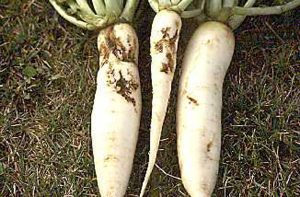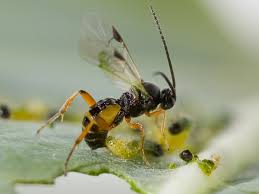Root maggots attack the roots of vegetables like carrots and turnips. They can lead to serious problems in your vegetable garden including black rot and the destruction of newly planted seed beds. Thankfully, several natural solutions are available to combat these garden pests.
Frequented Areas

Root maggot damage to daikon radish
A root maggot’s favorite place to frequent are newly planted seed beds. In their adult form, they are black flies about the size of a common house fly. They lay their eggs at the root of their plants of choice. These include a wide variety of root vegetables or tubers like radish, rutabaga, carrots, onions and flowering crucifers like cauliflower and cabbage.
In general, they frequent areas that have moist soil, vegetables of choice and succulent roots during the early season of planting. They are common across the world including North America and are some of the most destructive pests affecting home gardeners.
Identification – Physical Characteristics of Root Maggots
Root maggots are the larvae of flies, i.e. flies in their immature stage. They belong to the insect family Anthomyiidae in the order of Diptera. In their adult stage, they are about 1/5 inch in length but are bigger as larvae, with each root maggot measuring about ¼ inch long. The maggots are yellowish-white in color with a tapered head that they use to tunnel through the base of plants and feed on roots.
Root maggot infestation can be very destruction, especially when one considers the fact that an adult fly can lay up to 100 eggs on a single plant in two days or less. Within 3 to 10 days, these eggs will hatch, become larvae, and begin tunneling into the root tissue, resulting in serious damage to your plants.
Special Characteristics
The root maggots are known for their vast appetites and the tunnels they create in just about any vegetable they come across. Once they infest your garden, you can expect to see deep tunnels in the roots, stems and leaves. Due to the vigorous feeding tunnels and surface scars they leave on plants, your garden vegetables will be more susceptible to developing infection from soft-rot bacteria or be infested by thrips or springtail pests.
Removal and Preventative Procedures
Root maggots may be difficult to prevent but there are several steps home gardeners can take to control infestation. Once you see signs of surface scars, feeding tunnels or maggots in your plants, do not hesitate to implement the suggestions in the checklist below.
- Use diatomaceous earth at the base of seedlings
This sand-like material should be applied early in the planting season right after each rainfall occurs. The application of this material will result in soil that is less attractive to flies who would otherwise lay root maggot eggs near your vegetables. Thankfully, this method is also environmentally friendly.
- Rotate crops each season
Ensure you plant crops in soil that did not have root maggots during the previous season. Exposure to soil in which root maggot hosts were present is likely to result in further contamination or infestation in your garden vegetables. Though crop rotation may be difficult for home gardeners, it is an efficient method to reduce and control these dangerous garden pests.
- Place protective coverings over transplants or seedlings

Parasitic wasp laying eggs into a caterpillar
The use of protective coverings can restrict the maggots’ ability to thrive. To complete this procedure, place floating row covers over transplants and seedlings.
- Use cotton or waterproof discs to protect plants
If infestation is already in progress, be sure to add cotton, flat waterproof discs or other materials close to the stem of plants as well. This will place a strong barrier between the flies and the plants or soil in which they would lay their eggs.
- Use biological control methods via parasitic wasps or rove beetles
Parasitic wasps kill maggots that are close to the surface of your garden soil. Species of beetles like the rove beetle are also effective in controlling root maggot populations.
In Store or Chemicals
Pesticides are widely available both in stores and online for the control of pests. However, be cautious when purchasing chemicals for the control of root maggots. This is because there are currently no pesticides registered with the U.S. Environmental Protection Agency (EPA) for the control of these garden pests. If you determine, however, that you would like to use chemicals in your garden to eradicate root maggot larvae, consult a pest control professional.

No Comments